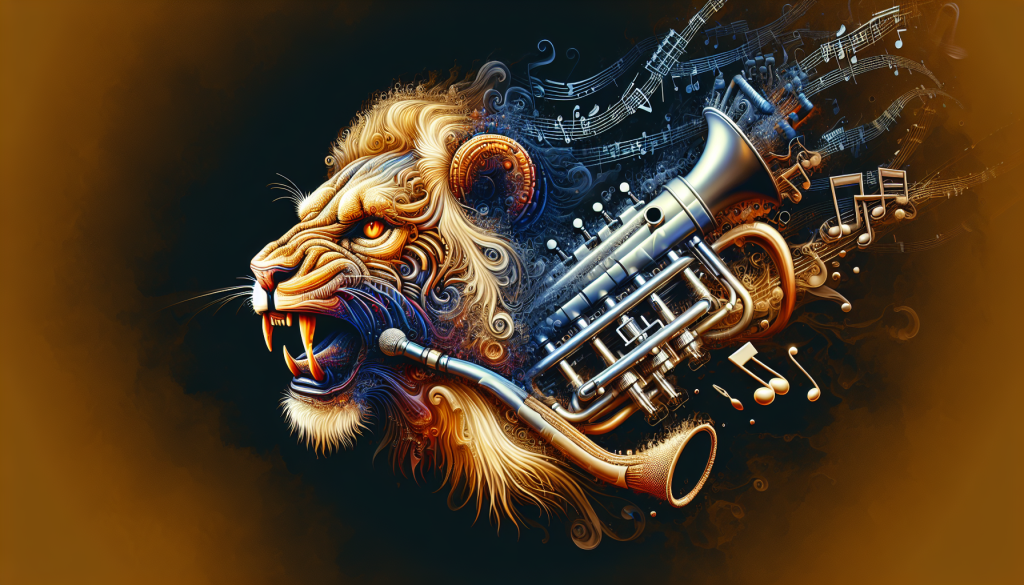Have you ever wondered about the various sounds that lions make? In this article, we will explore the fascinating world of lion vocalizations, taking you on a journey from their powerful roars to their unexpected chirps. Lions are known for their mighty roars that can be heard from miles away, but they also possess a wide range of other vocalizations that communicate different messages within their pride. From purring and moaning to grunting and even chirping, lions have a diverse repertoire of sounds that will leave you amazed. So, let’s dive into the world of lion vocalizations and discover the intriguing ways in which these magnificent creatures communicate.

Lion Communication
Lions are known for their majestic and powerful presence, and much of their communication is conveyed through various vocalizations and visual cues. This article will explore the different methods of communication used by lions, including their iconic roars, as well as other vocalizations such as purring, growling, and moaning. We will also delve into the way lions communicate visually through eye contact, facial expressions, tail position and movement, and posture. Additionally, we will discuss how lion cubs communicate with their mothers and examine the misconceptions and symbolism surrounding lion communication in movies. Furthermore, we will explore the science behind lion roars, including the anatomy of the roar, the roar to body size ratio, and the frequency of roaring. Lastly, we will touch upon the variations in vocalizations among lion subspecies and how these vocalizations are related to lion behavior, such as hunting and post-kill communication.
Roars as a Means of Communication
One cannot discuss lion communication without mentioning their iconic roars. The roar of a lion is both powerful and distinct, carrying for miles across the African savannah. It serves as a means of long-distance communication between members of a pride. Roars can convey various messages, such as declaring territory, displaying dominance, and even expressing social cohesion within the pride. The pitch and intensity of a roar can vary depending on the context and the lion emitting the sound.
Variations in Roar Structure
While roars are often associated with lions as a whole, there are notable variations in the structure of their roars. Male lions, known as the “king of the jungle,” have deeper and more resonant roars compared to females. These deep roars are believed to not only demonstrate their physical strength but also to intimidate potential rivals and attract potential mates. In contrast, female lions emit higher-pitched roars that are often shorter in duration. These roars serve to maintain contact with other pride members and coordinate movements during hunts.
Purpose of Roaring
Roaring serves multiple purposes in the lion kingdom. One of the key functions of roaring is territorial marking. By emitting powerful roars, lions can establish their presence and warn rival prides or solitary intruders to stay away. The roaring also serves as a form of communication within a pride, strengthening the bonds between members and allowing them to coordinate their activities, such as hunting or defending their territory. Roaring can also be a display of dominance, indicating the hierarchical order within the pride and determining which lions have the authority to lead and take charge.
Roaring and Territory
Lions are highly territorial animals, and roaring plays a crucial role in demarcating and defending their territories. When a lion roars, the soundwaves travel across the savannah, providing information about the territory’s boundaries to other lions in the vicinity. These vocalizations help lions avoid unnecessary conflicts by establishing clear territorial boundaries and maintaining a balance between prides. Roaring can also help prevent intergroup conflicts by signaling to neighboring prides that a territory is already occupied, reducing the chances of territorial encroachment.
The Purr: Understood as a Means of Communication
While roaring is often associated with dominance and strength, there are other vocalizations in the lion’s repertoire that convey different messages. The purr, for example, is commonly associated with contentment and relaxation in cats, and lions are no exception. Lions often emit low-frequency purring sounds when they are in a relaxed state, often during social interactions or when resting. Purring can serve as a means of communication between pride members, indicating a sense of calm and bonding within the group.
The Chuff: Close Communication and Affection
Another vocalization used by lions to communicate is the chuff. The chuff is a non-threatening vocalization that resembles a soft, rapid exhale through the nose. It is often used as a greeting or as a form of close communication between individuals within the pride. Lions may chuff at each other when they are in close proximity, expressing their affection and reinforcing social bonds. This gentle vocalization helps maintain a harmonious atmosphere within the pride and contributes to the overall cohesion of the group.
Meaning behind Growls
While roaring, purring, and chuffing are relatively well-known vocalizations of lions, growling is another important part of their communication repertoire. Growling is typically associated with aggression or perceived threats. When a lion emits a growl, it is often a warning sign to potential adversaries or rivals to back off. Growling can be accompanied by other visual cues such as bared teeth or raised hackles, further emphasizing the lion’s intention to defend itself or its territory. It is important to note that not all growls are hostile; some growls can be playful or used during social interactions within the pride.
Moaning: A Sign of Distress
In addition to growling, lions also have the ability to emit moaning sounds. Moaning is typically associated with distress, discomfort, or pain. Lions may moan when they are injured, hungry, or feeling unwell. This vocalization signals to other pride members that there is an issue at hand and can elicit a response from the group. Moaning is an important way for lions to communicate their needs and potentially receive assistance or support from other pride members.
Eye Contact
Visual communication is equally important in the lion kingdom, and one of the most direct ways lions communicate visually is through eye contact. Lions are capable of using their intense gaze to convey messages to both members of their pride and other lions in their vicinity. Maintaining eye contact can convey dominance, submission, or aggression, depending on the context. It can also serve as a means of bonding and strengthening social relationships within the pride.
Facial Expressions
Just like humans, lions can convey various emotions and intentions through their facial expressions. Their facial muscles are highly flexible, allowing them to exhibit a wide range of expressions. For example, when a lion is relaxed and content, its facial muscles may appear relaxed, and its eyes might be partially closed. On the other hand, if a lion is agitated or feeling threatened, its facial muscles may tense up, and its eyes may open wide to express aggression or fear. These subtle changes in facial expressions are crucial for their communication within the pride and with other species.
Tail Position and Movement
The position and movement of a lion’s tail can also communicate important messages. A relaxed, low-hanging tail generally indicates a calm and content lion. In contrast, a raised and tense tail can be a sign of aggression or potential danger. Lions may also use their tails to communicate playfulness or excitement, wagging or flicking it to show their mood. Observing the position and movement of a lion’s tail can provide valuable insights into their current state of mind and intentions.
Posture
Posture is another key aspect of lion communication. A dominant lion will often walk with a proud and commanding posture, holding its head high and its body upright. This posture conveys authority and dominance within the pride and is a display of power in the lion kingdom. In contrast, a submissive lion will adopt a more crouched and lowered posture, indicating deference to a dominant individual or submission to avoid confrontation. Posture plays a crucial role in establishing the social order within a pride and maintaining harmony within the group.
Babies Communicating with Mothers
Lion cubs have their unique set of vocalizations and communication methods, particularly when it comes to interacting with their mothers. From a very young age, lion cubs use vocalizations to communicate their needs and desires to their mothers. They may emit soft chirping sounds when they are hungry, seeking attention, or in need of comfort. The mother lion, in turn, responds to these vocalizations, attending to the needs of her cubs and providing them with the care and protection they require.

Chirping and Clicking
In addition to chirping, lion cubs may also emit clicking sounds. These clicking sounds are often produced during play and social interactions within the pride. Clicking can serve as a form of communication and coordination during playful activities or when cubs are trying to engage their siblings or parents. These vocalizations help strengthen the bond between the cubs and promote socialization within the pride.
Panting as a Sign of Distress
Similar to adult lions, lion cubs have their ways of communicating distress. When lion cubs are in distress, they may pant heavily as a sign of discomfort or unease. Panting can be an indicator of various issues, such as thirst, hunger, or fear. This vocalization prompts the mother or other pride members to investigate the source of distress and provide the necessary care or protection.
Misconceptions in Media Representations
Lion vocalizations, particularly roaring, are often sensationalized and misunderstood in movies and popular culture. For dramatic effect, filmmakers often use exaggerated roars that are louder, deeper, and more frequent than what is typically observed in the wild. These unrealistic representations can create misconceptions about lion behavior and communication, leading to inaccurate perceptions of their true capabilities and characteristics.
Roaring as a Symbol of Power
In movies and popular culture, lion roars are often depicted as a symbol of power and dominance. The loud and resonant nature of a lion’s roar is indeed awe-inspiring, and it can serve as an indicator of strength and authority within the animal kingdom. However, it is essential to remember that roaring is just one aspect of lion communication and that other vocalizations, such as purring and chuffing, play a crucial role in maintaining social bonds and communication within the pride.
Anatomy of the Roar
To understand the science behind lion roars, it is important to delve into the anatomy of the roar. Lions possess specialized vocal structures that enable them to produce their powerful roars. The primary vocalization mechanism involved in roaring is the larynx, commonly known as the voice box. Lions have a well-developed and flexible larynx, which gives them the ability to manipulate their vocalizations and produce the characteristic roar. The unique anatomy of the lion’s larynx allows air to pass through, resulting in the deep, resonant sound that we associate with their roars.
Roar to Body Size Ratio
One fascinating aspect of lion roars is the roar to body size ratio. Despite being smaller in size than their male counterparts, female lions have been found to produce roars that are equally powerful. This is due to the unique anatomy and vocal structures that allow lions to amplify their calls, regardless of their physical size. The roar to body size ratio in lions is a remarkable example of how adaptations in vocal mechanisms can compensate for physical differences and enable effective communication within the species.
Roaring Frequency
The frequency at which lions roar varies depending on the context and individual circumstances. Lions are most likely to roar during periods of social activity or when establishing or defending territory. Male lions, in particular, tend to roar more frequently than females, as their roars serve the dual purpose of asserting dominance and attracting potential mates. Roaring can also be triggered by external stimuli such as the presence of other lions or the need to communicate with distant members of the pride. The frequency of roaring is influenced by a range of factors, including social dynamics, environmental conditions, and the specific objectives of communication.
Variations in Vocalizations
Communication methods can differ between lion subspecies, leading to variations in vocalizations. For example, the East African lion subspecies is known for its robust and resonant roars, while the Central African lion is believed to have a broader repertoire of vocalizations. These variations can be attributed to ecological factors, genetic differences, and social dynamics within each subspecies. By understanding these variations, researchers can gain insights into the unique characteristics and behavior of different lion populations.
Roaring during Hunting
Communication is particularly essential during hunting, as lions need to coordinate their actions efficiently to secure a successful kill. While the iconic roar may not be as prominent during the actual hunt, it plays a crucial role leading up to it. Lions may engage in vocalizations such as low-intensity roaring or calling to gather members of the pride, strategize, and coordinate their movements. These vocalizations help ensure that the hunting group is synchronized and prepared to take down their prey effectively.
Communication in Group Hunting
Group hunting is a hallmark of lion behavior, and effective communication is instrumental in carrying out successful hunts. Lions often utilize non-vocal communication, such as eye contact and subtle body language, to coordinate their actions during a hunt. This silent communication can convey important information about the target, the direction of the hunt, and the roles each lion should play. By maintaining a tight line of communication, lions can maximize their chances of a successful kill.
Roaring after a Kill
After a successful kill, lions engage in various post-kill vocalizations. These vocalizations can range from low roars to contact calls, designed to notify other pride members about the availability of food and to facilitate their arrival at the feast. Post-kill vocalizations also serve as a means of reassuring and calming the pride, maintaining order and harmony during the crucial feeding period.
Conclusion
Communication is an integral part of lion society, allowing these majestic animals to maintain social bonds, coordinate their activities, and establish dominance and territories. Through their iconic roars, lions boldly announce their presence and communicate important messages to other individuals and prides. However, roaring is not the only form of communication in the lion kingdom. Lions also employ other vocalizations such as purring, chuffing, growling, and moaning to convey various emotions and needs. Visual cues, including eye contact, facial expressions, tail position and movement, and posture, further contribute to the rich communication repertoire of lions. By understanding and appreciating the complexities of lion communication, we can gain a deeper insight into their fascinating behavior and the intricate dynamics within their prides.

